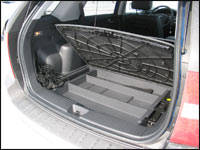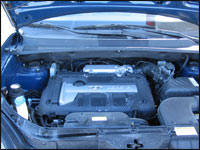Both trucks have similar interesting interior features such as a pop-forward  center armrest with storage and a standard height adjustable driver seat. Also, the second row 60/40 bench seat, folds flat in a single movement to create a perfectly flat cargo area. The rear also features a useful under-floor storage bin.
center armrest with storage and a standard height adjustable driver seat. Also, the second row 60/40 bench seat, folds flat in a single movement to create a perfectly flat cargo area. The rear also features a useful under-floor storage bin.
Forward and side visibility is very good for both trucks however the Sportage fairs better with a rearward view that is larger because of the sizeable pane of glass that covers the full hatch area.
Technical
There are two available contraptions for the Tucson and the Sportage. The first is a 2.0L inline 4-cylinder that develops 140 hp at 6 000 rpm and 136 lb/ft of torque at 4 500 rpm. The second is the 2.7L V6 engine also found in the Hyundai Santa Fe. It puts out 173 hp at 6 000 rpm and 178 lb/ft of torque at 4 000 rpm. There are two transmissions offered with the Tucson. The 4-cylinder can be mated to either a 4-speed autom atic or a 5-speed manual. The V6, on the other hand, is only available with the automatic transmission. The Tucson and Sportage are offered in either FWD or AWD form. The trucks have standard 4-wheels disc brakes and 16" alloy wheels.
atic or a 5-speed manual. The V6, on the other hand, is only available with the automatic transmission. The Tucson and Sportage are offered in either FWD or AWD form. The trucks have standard 4-wheels disc brakes and 16" alloy wheels.
On the road
The 4-cylinder engine is a little rough around the edges and noisy but sufficiently powerful for urban commuting. The one in the Tucson is noisier and a little raspier than the Sportage's for some reason. The V6 is smoother and cruises effortlessly; however it is not that much quicker than the 4 when it is equipped with the manual transmission. In a side-to-side comparison, the Sportage V6 AWD and the 4 cylinder 5-speed AWD were as quick in an 80 to 120 km/h sprint. At speeds just above the latter, the V6 would begin to pull away. Both engines could use a little more torque in the lower rev range. The Tucson's V6 felt livelier than that of the Sportage's. The difference probably stems from the fact that the Sportage was brand new and the Tucson was well broken-in.
In combined city and highway driving, I averaged 10.5 L per 100 km with the 5-speed FWD Tucson. The V6 AWD Tucson did much worse at 14L per 100 km. The Kia did even worse. It returned an average of 15.3L per 100 km. Again, this was most likely due to the newness of the engine. Natural Resources Canada quotes an average of about 10.5L per 100 km. I do not know what went wrong, but I can say that this is not the first incident concerning high fuel consumption with these vehicles.
Generally speaking, the automatic transmission works smoothly. However, it is slow to react on a kickdown and could even be considered a little lazy on the uptake. The shift lever of the 5-speed lacks precision and is not much fun to use in the Tucson. The one found in the Sportage is much better in all aspects.
The AWD system works sufficiently well for the terrain (i.e. streets) that these vehicles will regularly tread on. Both have a control button that allows the driver to lock the AWD system. When it is activated, the short delay between FWD and AWD traction is eliminated and grip becomes
almost instantaneous, as long as the stability control is deactivated. One thing I noticed after every short trek through snow, the steering wheel would vibrate tremendously at speeds beginning around 110 km/h. It appears to me that snow would always get lodged in the wheels and causes the unsightly shuddering. This would not be the first time that I hear or notice this about the design and style of a wheel. A mild day or a short stint in an indoor parking lot would solve the problem.
 center armrest with storage and a standard height adjustable driver seat. Also, the second row 60/40 bench seat, folds flat in a single movement to create a perfectly flat cargo area. The rear also features a useful under-floor storage bin.
center armrest with storage and a standard height adjustable driver seat. Also, the second row 60/40 bench seat, folds flat in a single movement to create a perfectly flat cargo area. The rear also features a useful under-floor storage bin.Forward and side visibility is very good for both trucks however the Sportage fairs better with a rearward view that is larger because of the sizeable pane of glass that covers the full hatch area.
Technical
There are two available contraptions for the Tucson and the Sportage. The first is a 2.0L inline 4-cylinder that develops 140 hp at 6 000 rpm and 136 lb/ft of torque at 4 500 rpm. The second is the 2.7L V6 engine also found in the Hyundai Santa Fe. It puts out 173 hp at 6 000 rpm and 178 lb/ft of torque at 4 000 rpm. There are two transmissions offered with the Tucson. The 4-cylinder can be mated to either a 4-speed autom
 atic or a 5-speed manual. The V6, on the other hand, is only available with the automatic transmission. The Tucson and Sportage are offered in either FWD or AWD form. The trucks have standard 4-wheels disc brakes and 16" alloy wheels.
atic or a 5-speed manual. The V6, on the other hand, is only available with the automatic transmission. The Tucson and Sportage are offered in either FWD or AWD form. The trucks have standard 4-wheels disc brakes and 16" alloy wheels.On the road
The 4-cylinder engine is a little rough around the edges and noisy but sufficiently powerful for urban commuting. The one in the Tucson is noisier and a little raspier than the Sportage's for some reason. The V6 is smoother and cruises effortlessly; however it is not that much quicker than the 4 when it is equipped with the manual transmission. In a side-to-side comparison, the Sportage V6 AWD and the 4 cylinder 5-speed AWD were as quick in an 80 to 120 km/h sprint. At speeds just above the latter, the V6 would begin to pull away. Both engines could use a little more torque in the lower rev range. The Tucson's V6 felt livelier than that of the Sportage's. The difference probably stems from the fact that the Sportage was brand new and the Tucson was well broken-in.
 |
Generally speaking, the automatic transmission works smoothly. However, it is slow to react on a kickdown and could even be considered a little lazy on the uptake. The shift lever of the 5-speed lacks precision and is not much fun to use in the Tucson. The one found in the Sportage is much better in all aspects.
The AWD system works sufficiently well for the terrain (i.e. streets) that these vehicles will regularly tread on. Both have a control button that allows the driver to lock the AWD system. When it is activated, the short delay between FWD and AWD traction is eliminated and grip becomes
 |


